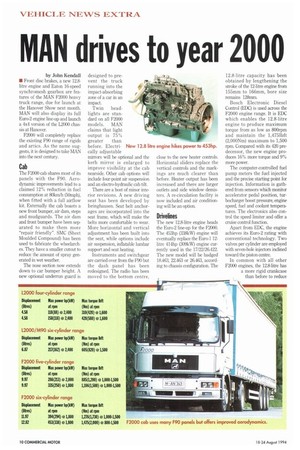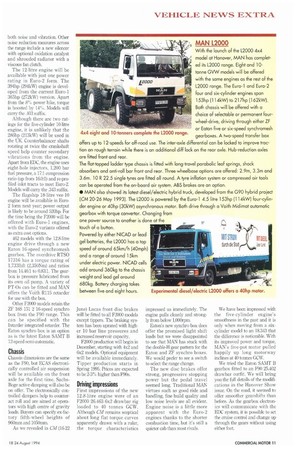MAN drives to year 2000
Page 12

Page 13

If you've noticed an error in this article please click here to report it so we can fix it.
by John Kendall • Front disc brakes, a new 12.8litre engine and Eaton 16-speed synchromesh gearbox are features of the MAN F2000 heavy truck range, due for launch at the Hanover Show next month. MAN will also display its full Euro-2 engine line-up and launch a 4x4 version of the L2000 chassis at Hanover.
F2000 will completely replace the existing F90 range of rigids and artics. As the name suggests, it is designed to take MAN into the next century.
Cab
The F2000 cab shares most of its panels with the F90. Aerodynamic improvements lead to a claimed 12% reduction in fuel consumption at 801an/h (50mph), when fitted with a full airflow kit. Externally the cab boasts a new front bumper, air dam, steps and mudguards. The air dam and front bumper have been separated to make them more "repair friendly". SMC (Sheet Moulded Compound) has been used to fabricate the wheelarches. They have a smaller cutout to reduce the amount of spray generated in wet weather.
The nose section now extends down to car bumper height. A new optional underrun guard is designed to pre vent the truck running into the impact-absorbing zone of a car in an impact.
Twin headlights are standard on all F2000 models. MAN claims that light output is 75% greater than before. Electrically adjustable mirrors will be optional and the kerb mirror is enlarged to improve visibility at the cab nearside. Other cab options will include four-point air suspension and an electro-hydraulic cab tilt.
There are a host of minor interior revisions. A new driving seat has been developed by Isringhausen. Seat belt anchorages are incorporated into the seat frame, which will make the belts more comfortable to wear. More horizontal and vertical adjustment has been built into the seat, while options include air suspension, inflatable lumbar support and seat heating.
Instruments and switchgear are carried over from the F90 but the dash panel has been redesigned. The radio has been moved to the bottom centre, close to the new heater controls. Horizontal sliders replace the vertical controls and the markings are much clearer than before. Heater output has been increased and there are larger outlets and side window demisters. A re-circulation facility is now included and air conditioning will be an option.
Drivelines
The new 12.8-litre engine heads the Euro-2 line-up for the F2000. The 453hp (338kW) engine will eventually replace the Euro-1 12litre 414hp (309kW) engine currently used in the 17/22/26.422. The new model will be badged 18463, 22.463 or 26.463, according to chassis configuration. The 12.8-litre capacity has been obtained by lengthening the stroke of the 12-litre engine from 155mm to 166mm, bore size remains 128m.m.
Bosch Electronic Diesel Control (EDC) is used across the F2000 engine range. It is EDC which enables the 12.8-litre engine to produce maximum torque from as low as 800rpm and maintain the 1,4751bft (2,000Nm) maximum to 1,500 rpm. Compared with its 420 predecessor, the new engine produces 16% more torque and 9% more power.
The computer-controlled fuel pump meters the fuel injected and the precise starting point for injection. Information is gathered from sensors which monitor accelerator pedal position, turbocharger boost pressure, engine speed, fuel and coolant temperatures. The electronics also control the speed limiter and offer a cruise control function.
Apart from EDC, the engine achieves its Euro-2 rating with conventional technology. Two valves per cylinder are employed with seven-hole injectors inclined toward the piston centre.
In common with all other F2000 engines, the 12.8-litre has a more rigid crankcase than before to reduce both noise and vibration. Other noise reduction measures across the range include a new silencer with optional oxidation catalyst and shrouded radiator with a viscous fan clutch.
The 12-litre engine will be available with just one power rating in Euro-2 form. The 394hp (294kW) engine is developed from the current Euro-1 365hp (272kW) version. Apart from the 8% power hike, torque is boosted by 14%. Models will carry the .403 suffix.
Although there are two ratings for the five-cylinder 10-litre engine, it is unlikely that the 286hp (213kW) will be used in the UK. Counterbalancer shafts rotating at twice the crankshaft speed help counter secondary vibrations from the engine. Apart from EDC, the engine uses eight-hole injectors, 1,200 bar fuel pressure, a 17:1 compression ratio (up from 16.0:1) and re-profiled inlet tracts to meet Euro-2. Models will carry the .343 suffix.
The flagship 18-litre vee-10 engine will be available in Euro2 form next year; power output is likely to be around 520hp. For the time being the F2000 will be offered with Euro-1 engines, with the Euro-2 variants offered as extra cost options.
462 models with the 128-litre engine drive through a new Eaton 16-speed synchromesh gearbox. The overdrive RTSO 17316 has a torque rating of 1,7331bft (2,350Nm) and ratios from 14.46:1 to 0.83:1. The gearbox is pressure lubricated from its own oil pump. A variety of PT-Os can be fitted and MAN offers the Voith RI15 retarder for use with the box.
Other F2000 models retain the ZF 16S 151 2 16-speed synchro box from the F90 range. This can be specified with the Intarcler integrated retarder. The Eaton synchro box is an option as is the latest Eaton SAMT B 12-speed semi-automatic.
Chassis
Chassis dimensions are the same as the F90, but ECAS electronically controlled air suspension will be available on the front axle for the first time. SachsBoge active clamping will also be on offer. The electronically controlled dampers help to counteract roll and are aimed at operators with high centre of gravity loads. Buyers can specify ex-factory fifth-wheel heights of 960mm and 1050mm.
As we revealed in CM (16-22
June) Lucas front disc brakes will be fitted to all F2000 models except tippers. The braking system has been uprated with higher 10 bar line pressures and increased reservoir capacity.
F2000 production will begin in December, starting with 4x2 and 6x2 models. Optional equipment will be available immediately. Tipper production starts in Spring 1995. Prices are expected to be 2-3% higher than F90s.
Driving impressions
First impressions of the new 12.8-litre engine were of an F2000 26.463 6x2 drawbar rig loaded to 40 tonnes GCW. Although CM remains sceptical about long flat torque curves apparently drawn with a ruler, the torque characteristics impressed us immediately. The engine pulls cleanly and strongly from below 1,000ipm.
Eaton's new synchro box does offer the promised light shift loads but we were disappointed to see that MAN has stuck with the double-H gear pattern for the Eaton and ZF synchro boxes. We would prefer to see a switch to select the range change.
The new disc brakes offer strong, progressive stopping power but the pedal travel seemed long. Traditional MAN virtues such as good ride and handling, fine build quality and low noise levels are all evident. Engine noise is a little more apparent with the Euro-2 engines thanks to the shorter combustion time, but it's still a quieter cab than most rivals.
We have been impressed with the five-cylinder engine's smoothness in the past and it is only when moving from a sixcylinder model to an 18.343 that the difference is noticeable. With its improved power and torque, MAN's five-pot motor pulled happily up long motorway inclines at 40 tonnes GCW.
We tried the Eaton SAMT B gearbox fitted to an F90 25.402 drawbar outfit. We will bring you the full details of the modifications in the Hanover Show issue. On the road, it seemed to offer smoother gearshifts than before. As the gearbox electronics will communicate with the EDC system, it is possible to set the cruise control and change up through the gears without using either foot.
























































































